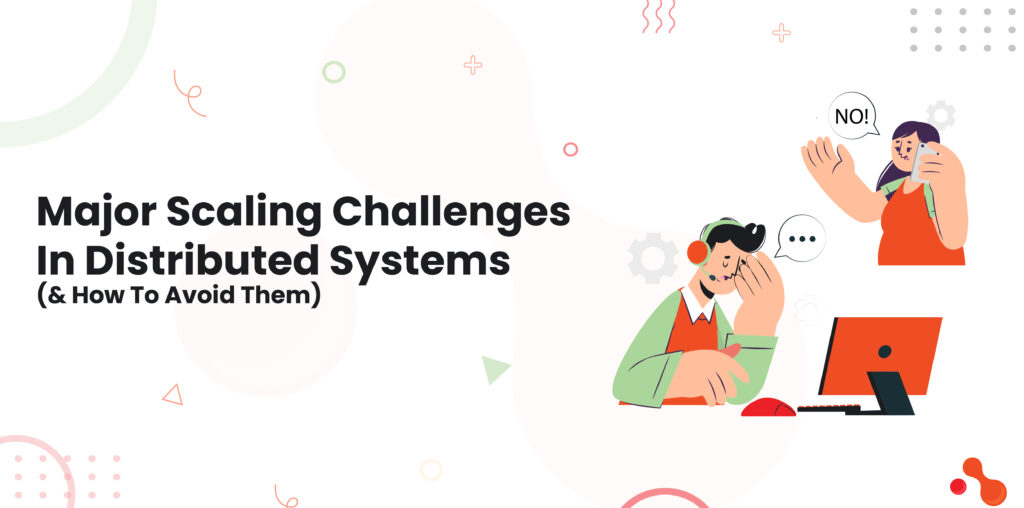Introduction
Date: 21 April 2025, Original Source:(https://hire-a-remote-developers.blogspot.com/2025/04/top-scalability-best-practices-for.html ) We recently shed light on top case studies about scalability best practices for startups. As scalability is a crucial factor for maintaining a super-responsive system, so is its planning. Only bragging about any unexpected flux and then submitting to it isn’t going to yield anything for your business.
The balance of scalability needs to step ahead!
According to a recent study, businesses must make their systems ready to handle traffic spikes with the utmost security, reliability, and scalability. It’s more of an art to design and adapt a system according to changing market demands and business requirements.
Importance of Scalability in Web Applications—Why Do Systems Fail?
Before knowing the scalability best practices for startups, you need to be aware of the importance of scalability in web applications. In most cases, traffic spikes cause the system to fail; these spikes aren’t a rare event, though. It often occurs with product launches or at any major event, viral sale, or anything that drives more traffic!
Though companies want to experience traffic hikes, if they don’t know about top database solutions for handling high traffic, then it’s a hard way to conquer. The system needs to be prepared first to handle the traffic spike.
Why Scalability Matters for Startups?
The growing base of startups adopting software product engineering services is showing that scalability is crucial to keep their business aligned with the current market trends. With the right strategies, the chaos of traffic spikes can be solved and controlled into a seamless and smooth digital experience.
To prepare a system that guarantees service and optimal performance, you must know these aspects vital for startups—
Scalability matters the most for business startups because of…
Cost efficiency:
If you’re looking to build a resilient, rapid system with minimal cost increments, then you need scalability. It allows you to serve more customers with a minimum of resources and investments. Furthermore, you can improve your profit margins over time.
Competitive Edge:
If you can scale better than your competitors, you can get better market share as well. With scalability, you can meet the demand spikes much better and stay competitive!
Investment Appeal:
If you implement cost-effective strategies for performance optimization, then this scalability signals huge potential for investors.
Growth Potential:
You’ve got immense growth potential by opting for scalability for your system. Plus, you get the chance to reach a wider audience and market segments without any major investment in your system infrastructure.
Operational Leverage:
Startups can experience immense operational automation by implementing affordable solutions for legacy system scalability.
System Scalability and Impact of Traffic Spike
With growth, important signs for scaling system architecture occur. It depends upon your business how early or later you will adopt the scalability metrics. However, for your information, traffic spikes have an effective impact on system performance.
Infact, here’s a complete list of the impact of traffic spikes on system’s scalability—
System Latency:
Users can experience system latency due to slower response time for the source server. When traffic hikes, the absence of efficient scaling overloads servers, due to which they do not handle every request or complete the required actions.
Service Outage:
When a system’s infrastructure becomes inefficient to handle the traffic surge, then it may lead to frequent system downtime, error messages, timeouts, etc. This series of interrupted workflows results in a negative system impact on users.
Decreased Responsiveness:
System works on its efficiency levels, and when traffic spikes occur, high volumes of concurrent data requests can spoil the backend work systems. As a result, they will become unresponsive and laggy. Furthermore, a delayed data retrieval will impact the overall system’s usability.
Poor User Experience:
Lack of system scalability during a traffic hike will result in performance degradation. Further, this will result in interrupted system access, leading to frustrated users and, finally, a negative reputation for your service.
Loss of Revenue Opportunities:
The biggest revenue-earning opportunities rely on the biggest traffic spike challenges. If your system cannot handle the surge, it may also lose potential sales opportunities and lead generation, and possible revenue declines as well.
By combining system modernization-based techniques, you can move ahead with these factors for preparing your system gradually:
Scalability Best Practices in Startups—How to Improve Application Performance?
To better handle traffic spikes, businesses must know the top database solutions for handling high traffic. Scalability vs. performance in software isn’t any big deal if you know the limits of a server, database, and network connections.
Building a Scalable, Stateless System Infrastructure
Contact a highly reputed software product engineering company to get the best deals on building a scalable business architecture. Stateless system architectures are clonable, hence, they can be scaled to infinite levels. Adopting horizontal scaling measures will make your system scaling process even higher.
There’s vertical scaling also, which particularly works for many cases. You can learn more about the pros and cons of horizontal vs. vertical scaling by consulting a top software expert. But you must remember that scaling is just about adding/removing servers. It is about matching the market demands in real time.
What works?
Adopting cloud services
Kubernetes for container orchestration
Load-balancing techniques for improved scalability
AWS Auto Scaling, Google Cloud Managed Instance Groups, and other auto-scaling tools
Relieve System Stress with Caching and CDNs
Implementing the right caching strategies will optimize the system performance and keep up with reducing extra stress regularly. Plus, now it’s quite easier to set up caching and CDNs at cost-effective rates!
To keep your system stress-free, you must ensure that the back-end servers can focus on critical tasks and do not engage in handling repetitive system requests. Implementing CDNs for static content will work wonders for your business by reducing the workload and latency effect on the source server. Each of these aspects helps to address and solve specific system challenges with scalability.
According to a report in Statistica, almost 67% of global enterprises adopted public cloud service providers for their services. Now that its so important to leverage such modernized service architectures, it’s evident to take up relevant measures to elope your system from workload.
What to do?
Redis, Memcached for dynamically accessing data and reducing database load
HTTP-level caching for static system responses
Cloudflare, AWS CloudFront-like tools to distribute static data globally
Ensure code optimization for efficiency.
Prioritize System Agility with Automation and Load Balancing
In a system, adapting to changing market situations via agile methodologies is important. Therefore, investing in scalable tools to ensure seamless system functioning, analytics, CRM, or payment processing becomes vital. You must adopt top-rated, scalable databases for securely handling large-scale datasets, with the most sophisticated automation.
Configuring an enabling automated scaling and deployments (CI/CD pipelines) will scale your system high and low according to the market’s situation. You must make sure to distribute the traffic with prompt load balancing techniques. Pair the automation tools with agile load balancers (names below) to distribute incoming requests efficiently!
What to do?
Adopt scalable databases like Amazon Aurora or Google BigQuery. Use Google Cloud Autoscaler or Azure VM Scale Sets.
Load balancing algorithms like Round Robin, least Connections for detecting traffic patterns.
Pair with AWS Elastic Load Balancer, NGINX, HAProxy, or ELB.
System Monitoring, Rate Limiting, and Queuing
Set up a robust system monitoring technique and observe the traffic flow in your application and key metrics like CPU, latency, error rates, etc., in real time. You must hold clear visibility into your infrastructure. For this, you need to identify, detect, and address system issues. You must also enable health checks for quickly detecting service failures and automated traffic rerouting.
Controlling the traffic flow is as important as monitoring. Implement rate limiting and traffic shaping, which act like the door bearers of responsive services when traffic spikes occur. Load balancers come with inbuilt controls, so you just need to configure them. Optimize your database as early as possible and utilize Laravel queuing for background tasks to ensure smooth operation.
What to do?
Apply rate limits and throttle/block suspicious patterns.
Use Laravel Queues, RabbitMQ, Amazon SQS, or Redis queues.
New Relic, Datadog, Prometheus + Grafana, and Laravel Telescope for predicting traffic spikes
Index queries, avoid N+1 problems, horizontal partitioning, and read replicas when scaling demands. New Relic or CloudWatch for real-time system monitoring
Use traces for individual requests and set up critical system failure alerts
Plan Load Test & Backup for Worst
Now that you are reaching this stage of the system scaling technique, load test for its adaptability with the traffic spikes. You need to adjust the auto-scaling rules and caching policies and analyze the past scenarios to identify the system’s weak points. Remember that every traffic spike gives your system a chance to become more resilient (for the next one)!
There are many unforeseen issues within every system, even with the best ones. You must plan a robust backup and disaster recovery plan as early as possible. Hold your focus on customer acquisition and retention strategies and provide reliable solutions. While system scaling prevents failures, disaster recovery makes sure that the system is prepared even if it happens.
What to do?
Utilize tools like k6, Locust, Apache Bench, and JMeter.
Create standard operating procedures (SOPs).
Adopt microservices system architecture and use serverless functions like AWS Lambda for modular scaling.
Use tools like Nakivo VM Disaster Recovery and Veeam Backup & Replication.
Conclusion
Be it about scalability best practices for startups, first impressions are everything. Mostly, startups don’t stand any second chance if they fail to scale and maintain the pace. Traffic spikes, at times, can be quite thrilling, but they come with hefty costs If you’re not ready for the aftermath, results can be quite frustrating.
By implementing the above-written scalability best practices for startups, you can efficiently handle the system traffic and maintain its optimal performance. System scalability unlocks superior business opportunities, allowing businesses to expand their reach globally. With the right vision and scalability metrics, it’s indeed a successful journey with so many lessons to learn and long-term success!
FAQs
When must a startup think about system scalability?
Businesses must start thinking about system scalability right from the time they plan their startup— that is, from day 1. It’s evident and proven in many ways that deciding to scale your system early will help businesses get in a better position, eventually.
Which architecture is better for scaling—microservice or monolith?
It’s not like monoliths don’t scale, but only to a certain degree. Businesses are adopting microservice architecture on a wider scale because it is easier to scale as compared to monoliths. They also feature better functionalities to efficiently handle traffic loads. To know more about this, you can consult a software expert!




